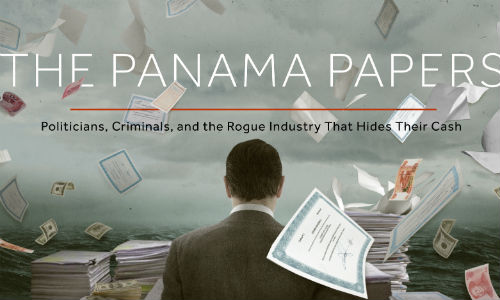Yesterday evening the 2016 Barlett & Steele Gold Award was awarded to “The Panama Papers,” the massive investigation that revealed Panama as a tax haven through which some of the globe’s dirtiest money flows. The Center for Public Integrity’s International Consortium of Investigative Journalists, Süddeutsche Zeitung and 107 media partners worldwide searched 11.5 million files documenting nearly four decades of criminal dealings. In their own words, here’s how they did it.
On April 3 the International Consortium of Investigative Journalists and more than 100 other media partners from around the world began publishing the largest investigation in journalism history: The Panama Papers.
The investigation into a massive trove of leaked documents uncovered offshore companies linked to 140 politicians in more than 50 countries – including 12 current or former world leaders – as well as offshore entities tied to Syria’s civil war, the looting of Africa’s resources and a network of people close to Russian President Vladimir Putin that shuffled as much as $2 billion around the world.
The project began when a confidential source leaked the digitized internal records of a Panama-based law firm to reporters at German newspaper Süddeutsche Zeitung. The German journalists shared the documents with ICIJ so that the U.S.-based investigative reporting consortium could put together a partnership that would allow ICIJ, Süddeutsche Zeitung, McClatchy, Fusion and other media around the world to join together to investigate the explosive documents.
The challenges of sifting through an enormous leak of data and coordinating a team of hundreds of journalists required a new level of sophistication in data journalism and investigative reporting. It required asking news professionals on every corner of the planet to embrace two ideas that journalists often aren’t known for: patience and teamwork.
The technical challenge
One set of obstacles was technical: How to take the largest leak in journalism history–which included spreadsheets, emails, PDFs and obscure formats no long longer in use–and make it searchable for a team of hundreds of journalists. The cache totaled 2.6 terabytes of data–nearly 11.5 million files documenting the creation and operation of 214,000 offshore companies over a period of almost 40 years. Most of the data was unstructured. The database didn’t come to the team in its raw, original format. It took intense reverse-engineering to reconstruct the database, and connect the dots based on codes found within the documents. ICIJ created an army of more than 30 temporary servers to process the documents and perform optical character recognition on PDF and TIFF files.
ICIJ adapted open source tools to create a virtual newsroom where reporters could securely communicate and platforms where they could access the documents and visualize global networks of offshore company ownership. The communications platform, known as the Global I-Hub, allowed journalists to share files, send private messages, post announcements and motivate one another during 12 months it took to bring the project to fruition.
The human challenge
A second set of obstacles was sociological: How to get hundreds of hyper-competitive journalists to work as a team. More than 370 journalists from nearly 80 countries, speaking dozens of languages and working across multiple time zones, joined the investigation. The key to making the collaboration work was getting team members to embrace ICIJ’s model of “radical sharing.” This meant not only swapping information with colleagues in other countries but also with media organizations that are direct competitors in their own countries.
Getting everyone to share information and publish at an agreed-upon date and time involved building trust and an understanding that together they could produce stronger, deeper stories with global reach and impact. That trust was tested but never broken as partners worked on the Panama Papers investigation. It was hard to agree on a publication date. It was even harder to see news break about cases that were thoroughly covered in our documents and convince partners to hold off until the go-date for everyone.
The material challenge
A third set of obstacles involved the complexity of the subject matter: How to fathom transactions that by definition were designed to obscure what was really going on. ICIJ’s in-house reporters and team members from other media outlets spent months sussing out the connections within “layered” offshore structures in which companies represented by “straw men” directors were controlled by successions of other companies, trusts and fronts.
To penetrate murky chains of control and connection, ICIJ and its partners deployed different software tools and techniques to help analyze and explore the data, and used our own Global I-Hub online communications platform as well as video and secure messaging apps, encrypted email and more to swap information with fellow team members in far-flung time zones. Within ICIJ’s Global I-Hub, members of the team created more than 130 subgroups to discuss topics related to the investigation. For example, 19 journalists from Russia, Germany, the United States, the United Kingdom, Switzerland, Austria and Finland contributed to the discussion forum regarding Sergey Roldugin, a family friend of Russian President Putin and one of the men involved in the offshore money network linked to Putin’s inner circle. In another subgroup, dozens of television partners from around the world coordinated key interviews, pooled shared footage and worked together on stories of mutual interest.
In all, the Panama Papers journalists shared nearly 12,000 findings, ideas, tips, questions and other information about topics that ranged from Zimbabwean President Robert Mugabe to suggestions on how search for passports within the Panama Papers database.
As the discoveries mounted, subgroups of team members spent hours on the phone and online video chats–comparing notes, picking each other’s brains and using their combined knowledge to make sense of byzantine offshore structures and double- and triple-check each other’s findings.
Media partners’ simultaneous publication and broadcast of their stories became one of the most talked-about events in journalism history. Mediashift, a news and technology journal, called the Panama Papers a “shining moment for investigative journalism” that points toward a future “where no one in power is safe, dark money can be exposed, and state secrets can become tomorrow’s headlines.”











